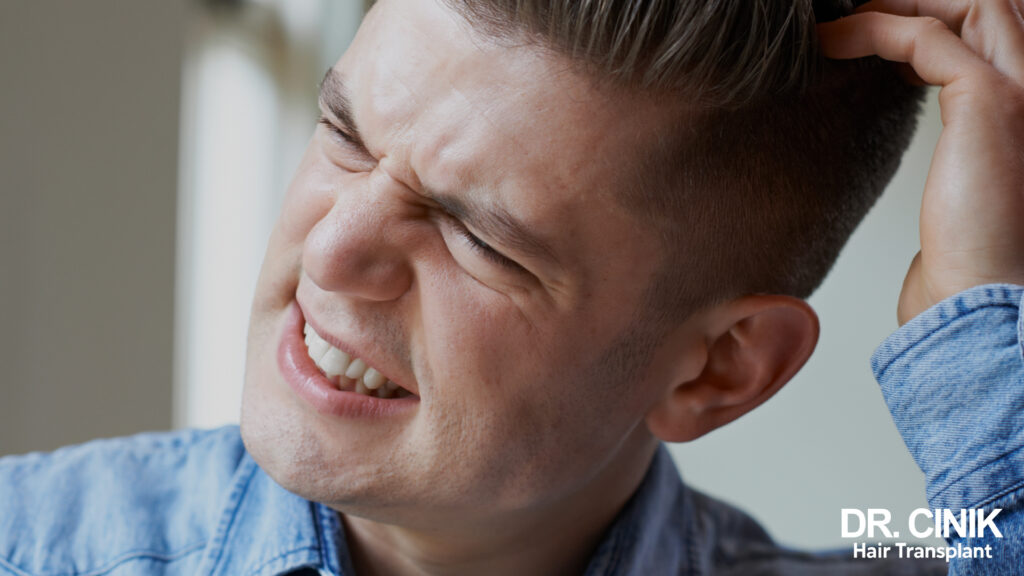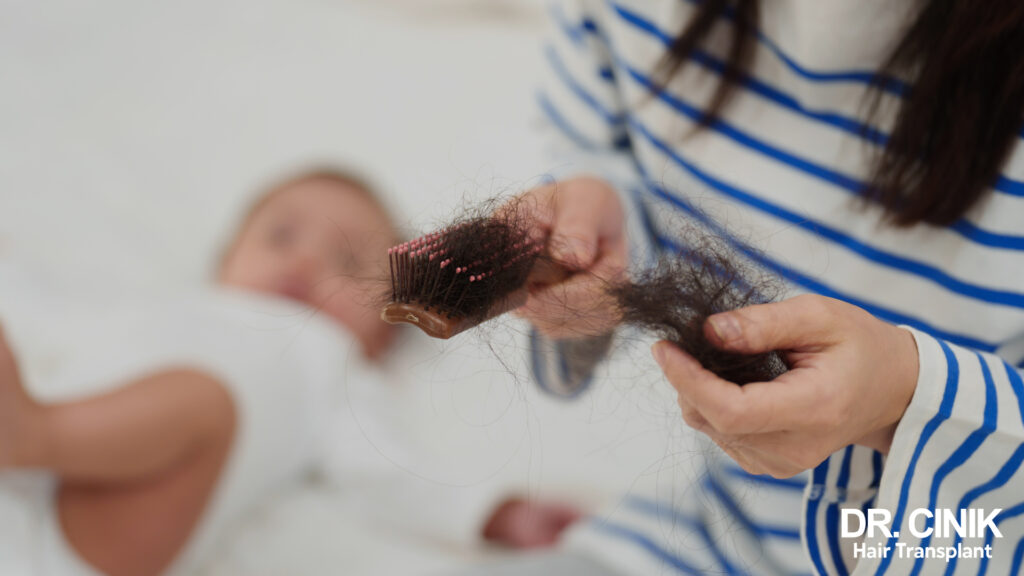Itchy Scalp and Hair Loss: What Causes Them?

Summary
An itchy scalp and hair loss are two common hair-related problems. While these symptoms can occur independently, they are often linked and share common causes. Scalp itchiness can be a warning sign of an imbalance that also affects the health of the hair follicles. Skin condition, allergic reaction, hormonal imbalance – discover all the causes and available solutions.
Scalp pruritus (itchiness) is a frequent complaint in dermatology, affecting around 25% of the general population (Misery et al., 2008). This unpleasant sensation can be particularly debilitating and significantly impact the quality of life of those affected.
Why Does My Scalp Itch and My Hair Fall Out?
The association between scalp itchiness and hair loss is not always coincidental.
An itchy scalp is generally a sign of irritation or local inflammation. This inflammation can disrupt the normal hair growth cycle and weaken the hair’s anchor in the hair follicle. Furthermore, the itchiness can lead to scratching, a behaviour that, when repeated and intense, can mechanically damage the hair follicles and accelerate hair loss (Vázquez-Herrera et al., 2017).

Many factors can trigger this vicious cycle. The accumulation of sebum, combined with bacterial or fungal proliferation on the scalp, creates an environment conducive to irritation and inflammation. Allergic reactions to certain hair products can also cause severe itchiness and weaken the hair roots.
Hormonal changes, particularly during periods like pregnancy, menopause, or in the case of endocrine disorders, can also alter the texture of the scalp and the structure of the hair, leading to the simultaneous onset of itchiness and hair loss.
The scalp has a complex innervation with a high density of free nerve endings that transmit the sensations of itchiness, which explains why this area is particularly sensitive to pruritus (Bin saif et al., 2011).
What Causes Hair Loss and Itchiness?

Alopecia Areata
Alopecia areata, also known as patchy baldness, is an autoimmune inflammatory condition that can simultaneously cause itchiness and characteristic hair loss. Contrary to some misconceptions, this condition is not caused by emotional factors, an underlying illness, or a viral infection.
Alopecia areata belongs to the family of autoimmune diseases, which means that the body turns against its own cells. In this case, the T lymphocytes, which are immune system cells normally tasked with protecting the body, mistakenly identify the hair bulbs as foreign bodies to be eliminated. These lymphocytes then attack the hair follicles, causing hair loss and sometimes loss of hair in other parts of the body.
Patients with alopecia areata often describe a tingling sensation on the scalp, which can lead to an irresistible urge to scratch. This sensation often precedes the appearance of the characteristic bald patches. These patches are generally well-defined, round or oval in shape, and can appear suddenly, sometimes even overnight.
Recent studies have shown that patients with active alopecia areata often complain of mild itchiness or burning sensations that generally precede the appearance of new patches. These symptoms could be caused by the release of histamine and tryptase by mast cells, as well as by lymphocytic infiltration with the release of IL-31 (Yamakoshi et al., 2013).

Scalp Psoriasis
Scalp psoriasis is a chronic inflammatory disease that specifically affects the scalp. It manifests as the appearance of characteristic red patches on the patient’s scalp. These patches are accompanied by the formation of thick, voluminous flakes and whitish scales that, in severe cases, can form a veritable shell covering certain areas of the scalp, the forehead, the nape of the neck, or the back of the ears.
The lesions caused by psoriasis cause intense itchiness that encourages scratching. This behaviour can worsen the condition of the skin, leading to significant scaling and sometimes even bleeding. In the most severe cases, scalp psoriasis can lead to scarring hair loss, where the hair follicles are permanently damaged (Almeida et al., 2013).
A recent study revealed that 80% of patients with scalp psoriasis suffer from itchiness, with a positive correlation between the severity of the lesions and the intensity of the pruritus (Kim et al., 2014). Furthermore, research has shown that 58% to 97% of patients with psoriasis suffer from itchiness, making it one of the most common and distressing symptoms of this condition (Vázquez-Herrera et al., 2017).
Did you know? Psoriasis evolves in flare-ups, meaning it will manifest through recurrent crises throughout the patient’s life, alternating with periods of remission. These fluctuations can make the management of the disease particularly challenging.

Seborrheic Dermatitis
Seborrheic dermatitis is an inflammatory reaction that primarily affects the upper layers of the skin, particularly in areas where sebaceous glands are most numerous, such as the scalp. These glands are responsible for producing sebum, a fatty substance that plays an essential protective role in forming the skin’s hydrolipidic film.
This condition, which can be hereditary, is often exacerbated by certain environmental factors such as hormonal changes or exposure to dry cold. It is characterised by the appearance of red patches covered with skin flakes, or dandruff, usually white or yellowish in colour. These flakes have the peculiarity of detaching easily, revealing an irritated, pink skin underneath.
Itchiness is one of the most troublesome symptoms of seborrheic dermatitis. Additionally, the affected skin can form crusts and lesions impregnated with sebum, as well as erythema – redness caused by inflammation of the skin tissues.
When it affects the scalp, seborrheic dermatitis forms patches that develop over the hair. These patches can disrupt the hair growth cycle and cause hair loss in the affected areas, although this loss is generally temporary and reversible with appropriate treatment.
Seborrheic dermatitis is the most common cause of scalp pruritus, affecting around 16% of the adult population. In a UK study, 50% of patients with this condition complained of scalp itchiness (Misery et al., 2013). The pathogenesis of this condition is complex and seems to result from interactions between the scalp skin, sebaceous secretions, Malassezia fungi, and the cutaneous immune system (Piérard-Franchimont et al., 2000).

How to Soothe an Itchy Scalp?
Scalp itchiness can significantly affect your quality of life, but fortunately, several solutions exist to effectively relieve it.
The first step is to identify and eliminate potential irritants. Start by re-evaluating your hair products – opt for gentle shampoos, free of sulfates and parabens, specially formulated for sensitive scalps.
Hydration also plays a crucial role. A dehydrated scalp can itch more, so make sure to drink enough water daily.
For more severe or persistent cases, consult a dermatologist who can prescribe appropriate medical treatments. Medicated shampoos are often effective against itchiness of fungal or inflammatory origin.

According to recent studies, certain targeted treatments can be particularly effective for specific types of scalp pruritus. For example, mu-opioid receptor antagonists and kappa-opioid receptor agonists have shown efficacy in treating various types of itchiness, including that affecting the scalp (Phan et al., 2010). Similarly, in cases of seborrheic dermatitis, shampoos containing zinc pyrithione have significantly reduced histamine levels in the scalp and, consequently, the intensity of itchiness (Kerr et al., 2011).
What Solutions Are There for Hair Loss?
Hair loss can have multiple origins and manifest in various ways depending on the individual. In men, it is mainly related to genetic heritage and the action of male hormones, particularly dihydrotestosterone (DHT), which accelerates the hair life cycle. Over time and after a certain number of cycles, the hair follicles become exhausted and cease to produce new hair, leading to baldness.

In women, the causes of hair loss are generally more varied and complex. They can be hormonal, such as during pregnancy or menopause, but also related to factors like chronic stress, thyroid disorders, diabetes, or certain nutritional deficiencies. Additionally, many medications, including chemotherapies, some antibiotics, or antidepressants, can also cause temporary or permanent hair loss.
The manifestations of hair loss vary considerably. It can be localised or diffuse, temporary or permanent. The classic male pattern baldness, or androgenetic alopecia, is characterised by a progressive and localised loss, usually on the top of the scalp and temples. In contrast, telogen effluvium, which often occurs after childbirth, general anaesthesia, or a significant psychological shock, results in a diffuse but temporary loss, with complete regrowth generally observed within 3 to 4 months of the triggering factor being resolved.
Given the diversity of causes and manifestations, solutions for hair loss must be tailored to each specific situation. Pharmaceutical treatments like Minoxidil and Finasteride can be effective for certain types of alopecia, while other situations may require more targeted approaches, such as corticosteroid injections for alopecia areata or antifungal treatments for fungal infections.

What Does Hair Transplant Surgery Involve?
Hair transplant surgery represents a long-lasting and effective solution for people suffering from permanent hair loss. This surgical procedure essentially involves harvesting hair from areas where it is still abundant, usually the back or sides of the scalp (donor area), and immediately reimplanting it in the regions that require increased density, such as the temples and top of the scalp.
Good to know: Although the term “transplant” is commonly used, it is actually an autograft, as the operation only relocates the patient’s own hair a few centimetres within the scalp.

Dr. Cinik is among the renowned specialists in the field of hair transplantation. His clinic offers personalised procedures using the most advanced techniques, such as FUE hair transplant and DHI hair transplant. His approach is distinguished by a particular focus on the natural appearance of the final result, notably through an implantation that respects the natural angle and direction of the hair. Dr. Cinik and his team also place great importance on post-operative care, a crucial element in ensuring the long-term success of the transplant and the satisfaction of patients.
Sources
Almeida, M. C., Romiti, R., Doche, I., Valente, N. Y. S., & Donati, A. (2013). Psoriatic scarring alopecia. Anais Brasileiros de Dermatologia, 88(6 Suppl 1), 29-31. https://doi.org/10.1590/abd1806-4841.20132241
Bin saif, G. A., Ericson, M. E., & Yosipovitch, G. (2011). The Itchy scalp – scratching for an explanation. Experimental Dermatology, 20(12), 959-968. https://doi.org/10.1111/j.1600-0625.2011.01389.x
Kerr, K., Schwartz, J. R., Filloon, T., Fieno, A., Vahle, J., Balasubramanian, N., & Gaines, K. (2011). Scalp Stratum Corneum Histamine Levels: Novel Sampling Method Reveals Association with Itch Resolution in Dandruff/Seborrhoeic Dermatitis Treatment. Acta Dermato-Venereologica, 91(5), 499-505. https://doi.org/10.2340/00015555-1073
Kim, T.-W., Shim, W.-H., Kim, J.-M., Mun, J.-H., Song, M., Kim, H.-S., Ko, H.-C., Kim, M.-B., & Kim, B.-S. (2014). Clinical characteristics of pruritus in patients with scalp psoriasis and their relation with intraepidermal nerve fiber density. Annals of Dermatology, 26(6), 727-732. https://doi.org/10.5021/ad.2014.26.6.727
Misery, L., Rahhali, N., Duhamel, A., & Taieb, C. (2013). Epidemiology of dandruff, scalp pruritus and associated symptoms. Acta Dermato-Venereologica, 93(1), 80-81. https://doi.org/10.2340/00015555-1315
Misery, L., Sibaud, V., Ambronati, M., Macy, G., Boussetta, S., & Taieb, C. (2008). Sensitive scalp: does this condition exist? An epidemiological study. Contact Dermatitis, 58(4), 234-238. https://doi.org/10.1111/j.1600-0536.2007.01288.x
Phan, N. Q., Bernhard, J. D., Luger, T. A., & Ständer, S. (2010). Antipruritic treatment with systemic μ-opioid receptor antagonists: a review. Journal of the American Academy of Dermatology, 63(4), 680-688. https://doi.org/10.1016/j.jaad.2009.08.052
Piérard-Franchimont, C., Hermanns, J. F., Degreef, H., & Piérard, G. E. (2000). From axioms to new insights into dandruff. Dermatology, 200(2), 93-98. https://doi.org/10.1159/000018337
Vázquez-Herrera, N. E., Sharma, D., Aleid, N. M., & Tosti, A. (2017). Scalp Itch: A Systematic Review. Skin Appendage Disorders, 4(3), 187-199. https://doi.org/10.1159/000484354
Yamakoshi, T., Andoh, T., Makino, T., Kuraishi, Y., & Shimizu, T. (2013). Clinical and histopathological features of itch in patients with alopecia areata. Acta Dermato-Venereologica, 93(5), 575-576. https://doi.org/10.2340/00015555-1613




